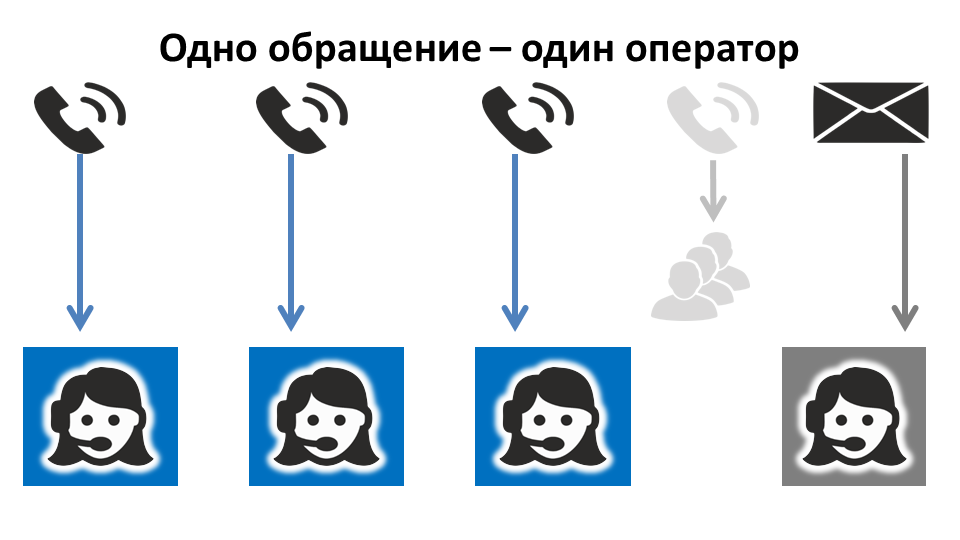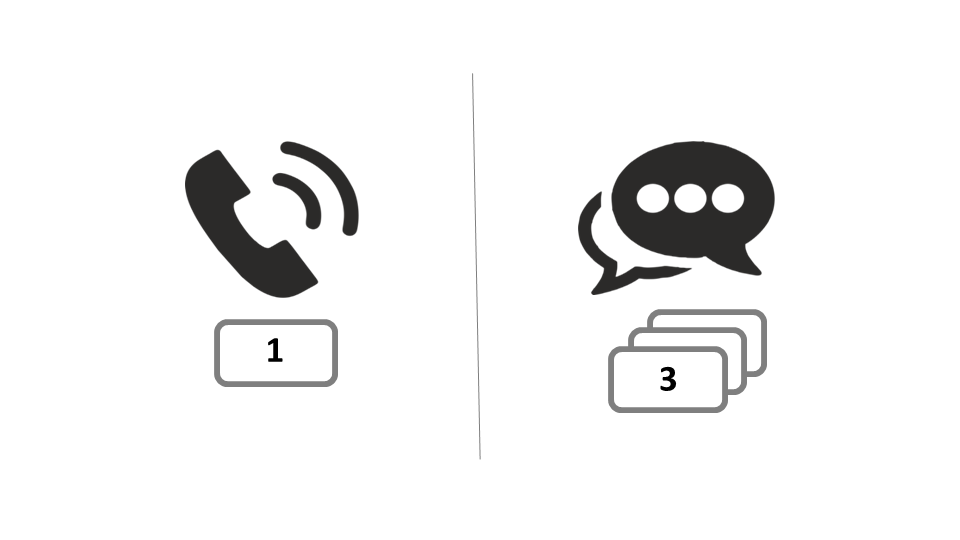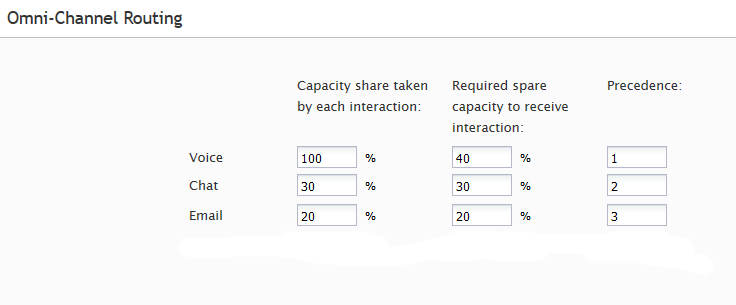Optimization of loading of multi-channel call center operators

In your opinion, how many calls can a modern call center operator handle at the same time: one, two or maybe ten?
If your answer is “more than one,” then this article is for you. From it you will learn how to solve in practice the problem of simultaneous processing of several calls using a special processing algorithm, known as the Agent Capacity Model .
')
One appeal is not enough
An ordinary person in a typical situation is concentrated on one task. Talking on the phone is a good confirmation of this observation. By the same principle, standard processing procedures are constructed in the CC: “ one appeal - one operator ”.
But new types of calls (e-mail, chat, mobile applications) do not require full concentration, giving the opportunity to allocate time for other tasks. Consider a chat session. When an operator participates in a chat with a client, he is idle for a certain time, waiting for a response. This time can be used more productively. For example, giving him the opportunity to accept a request in the chat from another client. It has been established that a qualified operator can participate simultaneously in 2-3 chat sessions without degrading the quality of service indicators.
In theory, there are no problems with loading the operator. But they arise with its implementation in practice. The traditional call distribution scheme used in most platforms for call centers (both foreign and domestic), when distributing a call to the operator, puts it in the “ Busy / Busy ” state.

Consider a typical situation: the operator responds to the e-mail from the client. Suppose that at a certain point in time a telephone request comes to the call center. All operators answering phone calls are busy. It would be logical in this situation, so as not to lose the call, send it to the operator processing the e-mail. Why?
The fact is that the processing of e-mail does not require a response in real time, in contrast to the telephone call. Traditional distribution schemes do not work in this situation, since the operator is in a busy state and cannot accept another call.
The concept of Rich Contact Experience (RCE) , which allows creating a unified environment of communication between clients and CC, can help in solving these problems. Note that using Rich Contact Experience you can process any number of contacts on any channels. Due to what?
The concept involves the use of special routing mechanisms (call distribution), taking into account the type of treatment and operator workload. Let's look at how it can be used to handle multi-channel downloads.
Operator load optimization
The task that needs to be solved is to move away from the principle of “ one appeal - one operator ” and provide an opportunity for the operator to simultaneously process several calls (with setting processing rules depending on the type of call and operator loading ).
These words were highlighted at the beginning of the article. The parameter " Agent Capacity " is the key to the task.
"Agent Capacity" is defined as the maximum number of hits that an operator can process per unit of time. For example, if one operator can participate in 3 chat sessions at the same time, then the “Agent Capacity” indicator is 3. Suppose that at this point in time the operator serves one chat request. In this case, the operator is not fully loaded yet and can accept 2 more chat calls (since in our example Agent Capacity = 3).
For phone calls, the “Agent Capacity” parameter should be taken as equal to 1, i.e. the operator can process only one phone call per unit of time (which corresponds to the rules adopted in most call centers).

Having already read half of the article, you can ask a reasonable question: “But what about the simultaneous processing of different types of requests? After all, the impossibility of solving this problem was cited as a criticism of the principle “one appeal - one operator” .
The answer is that the concept of RCE assumes that one type of request may or may not interrupt (depending on the settings, more on that later) other types of requests. For example, for the case of processing the e-mail given at the beginning of the article, you can specify that work with email. the mail will be interrupted by the arrival of a telephone call, but not vice versa. When a call arrives, the e-mail processing is put on hold, and the operator answers the telephone request. Upon its completion, the operator returns to work with email. by mail.
To configure the rules, two additional parameters are introduced: Interruption matrix and Max capacity vector .
The Interruption matrix is an NxN matrix, where N is the number of call types that the call center processes (voice, e-mail, chat, etc.). Each element of the matrix
As an example, consider the matrix INT and the vector MAX .
INT matrix describes the relationship between the three types of calls: voice, e-mail, chat. The first line refers to the voice. It means that a voice cannot be interrupted by any type of call (including another voice call). The second line describes the processing of e-mail. Its parameters show that the e-mail can be interrupted by voice and chat. Also, a new e-mail can be added to an already processed one. The third line indicates that the chat cannot be interrupted by voice and e-mail. Like e-mail, a new chat can be added to an existing one.
Max capacity vector MAX sets the maximum number of calls of the same type that the operator can simultaneously process. In our example, the following values are set: voice - 1, e-mail - 5, chat - 3.
The current status of the operator is described by an AS matrix of NxM size, where M is the number of contacts (clients) with which the operator is currently working, N are types of calls. Consider an example:
The size of the matrix indicates that the operator works with two contacts. The first contact includes only a telephone call. The second contact is to process the e-mail and chat session.
The Agent Capacity model works as a procedure that determines whether an agent can accept a new contact or not. Suppose a new contact includes e-mail and chat, which is determined by vector C :
To decide whether the operator can process the new contact, the following procedure is performed:
1. For each non-zero element of the vector C , it is checked whether this type of call can interrupt the current work of the operator or be added to it. Verification is done using the interruption matrix and max capacity vector . If it turns out that the operator’s work cannot be interrupted, the operator is considered “ unavailable ”.
2. If all new calls can interrupt or be added to existing ones: it is checked that the new number of calls does not exceed the maximum number specified in the MAX vector. If this condition is met, the operator is considered “ ready ” to receive this treatment. Otherwise, the operator is considered “ not ready ”.
In our example, it is easy to determine whether the operator can accept the call from the new contact C. The operator answers the phone call, so he will not be interrupted by e-mail and chat.
We give a diagram explaining how call routing works when using the “ Agent Capacity ” parameter. Suppose that all operators have the same interruption matrix and max capacity vector values, as in the examples above.
Client Vadim calls the call center with a chat request. All operators are already servicing calls from other customers. Operator Irina works with voice calls and e-mail from a single client. According to the rules set in our example, the voice cannot be interrupted. Operator Galina serves 3 clients in three chat sessions simultaneously. She will not be able to process a new request from Vadim , since in this case, the total number of requests (4) will exceed the maximum value set for chat requests (3). Operator Elena works with the client, processing the e-mail and chat message. Taking into account the settings made, it is she who will be able to accept a request from a new client.
In conclusion , let's see how in practice the operator load settings for the RCE model look. To do this, we will enter the application of the call center administrator in which the operators from our example work.
For the distribution of the operator's load is responsible for a number of settings, which are shown in Fig. below.

The 1st column ( Capacity share taken by each interaction ) determines how loaded the operator is when processing each type of request. In this example, a voice call takes 100% of the operator’s time (i.e., it can process only 1 voice call); chat: 30% (can simultaneously participate in 3 chat sessions); e-mail: 20% (can work simultaneously with 5 e-mail).
The 2nd column ( Required spare capacity to receive interaction ) determines how free an operator must be to accept this type of call.
For example, to participate in a new chat, the operator must be at least 30% free (in other words, loaded at 70%). This means that if it processes three chat rooms (download 90% = 30 + 30 + 30) or e-mail + voice (download 120% = 20 + 100), then with a new chat request, the operator will not be able to process it: for chat operator is 10% free (100-90), for e-mail + voice is fully occupied. And if the operator participates in one chat session and processes the e-mail (download 50%: 30 + 20), then he will be able to respond to the chat request, since he is 50% free (100-50).
Therefore, in our example, the new chat request was distributed to the operator Elena (chat + e-mail), and not to the operators Galina (participating in the chat) and Irina (e-mail + voice).
The 3rd column ( Precedence ) defines the priority of processing calls when the multi-channel call center is distributed to the operator. If the operator's load allows it to process several types of calls, the request with a higher priority will be processed first. For example, if there are requests for a chat session and an e-mail, then Elena will be assigned the chat to the operator, and the e-mail will be queued, since chat has a higher priority.
Thus, using fairly simple settings, an exact implementation of the distribution algorithm for multichannel calls is carried out, which we have analyzed in detail in this article.
Findings:
The implementation of the concept of Rich Contact Experience helps to solve two problems:
1) reduce the processing time of calls and reduce the number of lost calls
2) to provide the client with the opportunity to use that channel for circulation, which is convenient for him at the moment (for example, to start communicating on one channel, switching or using another channel an unlimited number of times).
As a result, the effect of using multi-channel increases, both when working with modern communication channels (voice, e-mail, chat, social network, video), and when new channels are connected in the future.
Source: https://habr.com/ru/post/297626/
All Articles